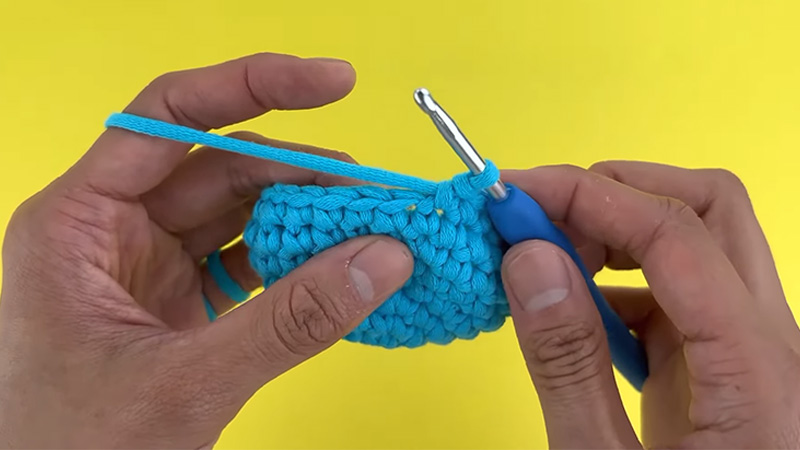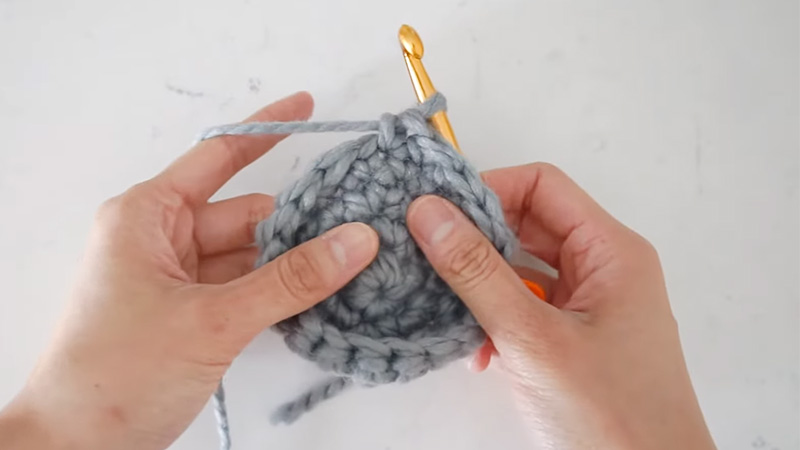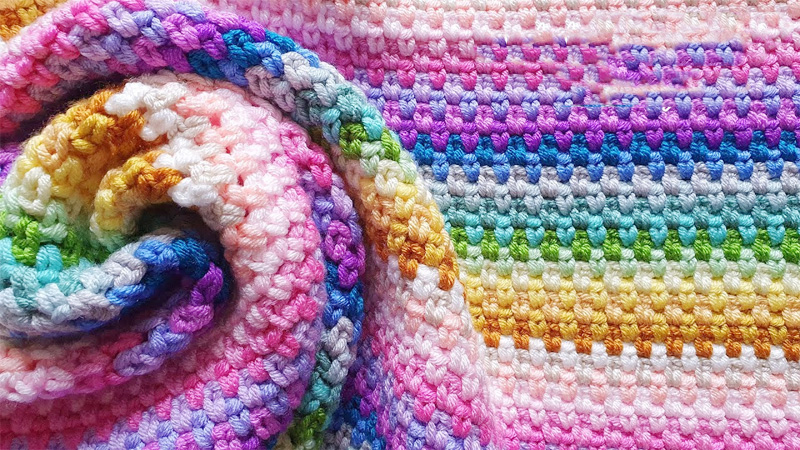The slip stitch, often abbreviated as SL ST in crochet patterns, maybe the smallest and simplest of crochet stitches, but it holds an indispensable place in the world of crocheting.
Learning how to slip stitch in crochet is like mastering the art of punctuation in writing; it connects, secures, and gives definition to your stitches and projects.
In this guide, we will embark on a journey into the world of slip stitching, exploring the various methods and applications of this versatile stitch.
From joining rounds and creating seamless finishes to adding decorative elements and working color changes, a slip stitch is a versatile tool that every crocheter should have in their repertoire.
So, whether you’re a beginner just starting your crochet adventure or an experienced crafter looking to expand your skills, let’s unravel the secrets of the slip stitch and discover how this humble stitch can elevate your crochet creations.

What Is The Crochet Slip Stitch?
The crochet slip stitch is one of the simplest and most versatile stitches in the world of crochet. It is a basic stitch that creates a nearly invisible, smooth join or seam in your crochet work.
To make a slip stitch, you insert your hook into a specific stitch or space, yarn over, and pull the yarn through both the stitch and the loop already on your hook. This action results in a tight, secure, and nearly flat stitch that doesn’t add much height to your project.
Slip stitches are commonly used for various purposes, such as joining rounds, creating seamless rounds, adding decorative edging, or fastening off. They are an essential tool in a crocheter’s repertoire, offering precision and a clean finish to a wide range of crochet projects.
Despite its simplicity, the slip stitch plays a crucial role in achieving a polished and professional look in crochet creations.
How To Slip Stitch In Crochet?
Learning how to slip stitch in crochet is a fundamental skill for creating smooth joins, finishing rounds, or adding decorative touches to your projects. Here are some simple methods to execute the slip stitch:
Basic Slip Stitch (SL ST)
To create a basic slip stitch, insert your hook into the designated stitch or space, yarn over (YO) with the working yarn, and pull the yarn through both the stitch and the loop already on your hook.
This results in a neat, flat stitch that’s often used for joining pieces, finishing rounds, or creating a secure fastening-off point.
Joining Rounds with a Slip Stitch (SL ST Join)
When working in the round, you can use a slip stitch to join the last stitch of a round to the first stitch.
Finish the last stitch as usual, then insert your hook into the top of the first stitch of the round, yarn over, and pull through both the stitch and loop on your hook. This creates a seamless join and allows you to continue crocheting in the round.
Invisible Slip Stitch (Invisible SL ST)
An invisible slip stitch is used when you want to create a nearly invisible join. Insert your hook under the top loops of the designated stitch, yarn over, and pull through both the stitch and the loop on your hook.
This method is excellent for finishing amigurumi or joining motifs with minimal visibility.
Slip Stitch Join in the Middle of a Row (SL ST Join Mid-Row)
To create a neat join in the middle of a row, simply slip the stitch into the desired stitch or space. Insert your hook into the designated stitch, yarn over, and pull through both the stitch and the loop on your hook.
This technique is handy for creating color changes or joining rows together seamlessly.
Slip Stitch Edging (SL ST Edging)
Add a decorative edge to your crochet project by slip stitching evenly around the edge of your work.
Insert your hook into the designated stitch or space, yarn over, and pull through both the stitch and the loop on your hook. Continue this process along the edge, creating a neat and even border.
Slip Stitch Chain (SL ST CH)
A slip stitch chain is used to create a secure foundation chain for edging or decorative elements. Insert your hook into the designated stitch or space, yarn over, and pull through both the stitch and the loop on your hook.
This creates a slip-stitch chain that you can work into for additional stitches.
Invisible Slip Stitch Join (Invisible SL ST Join)
The invisible slip stitch join is perfect for closing a round without a noticeable seam.
Finish your last stitch as usual, then insert your hook under both loops of the first stitch of the round, yarn over, and pull through both the stitch and the loop on your hook. This creates an almost invisible join, ideal for projects with continuous rounds.
Mastering these slip-stitch techniques will enhance your crochet skills and allow you to create clean, seamless finishes, join pieces effortlessly, and add professional-looking details to your crochet projects.
What Are Some Of The Best Slip Stitches Used In Crochet?

Slip stitches are versatile and find numerous applications in crochet projects. Here are some of the best slip stitches and their uses:
Joining Rounds (SL ST Join)
The slip-stitch join is commonly used to connect the last stitch of a round to the first stitch, creating a seamless and virtually invisible join. It’s indispensable in projects worked in the round, like hats, amigurumi, and circular motifs.
Seamless Rounds (Invisible SL ST Join)
The invisible slip stitch join is a variation of the SL ST join, producing a nearly invisible seam. It’s perfect for projects where you want the rounds to appear continuous without a visible join, such as crocheting a seamless tube.
Finishing Off (Basic Slip Stitch)
The basic slip stitch is often used to secure the final stitch of a project. After completing your last stitch, simply slip the stitch into the next stitch or space, creating a neat and secure finish.
Joining Granny Squares (Joining SL ST)
When assembling granny squares or other crochet motifs, the joining slip stitch is invaluable. It allows you to connect squares seamlessly and create beautiful blankets, shawls, or other multi-piece projects.
Creating Edgings (SL ST Edging)
Adding a decorative border or edging to your crochet work is made easy with slip stitches. Slip stitching evenly along the edge of your project can create a clean and polished finish, enhancing the overall look.
Securing Color Changes (SL ST Join Mid-Row)
In colorwork or stripes, slip stitches can help secure color changes. You can use a slip stitch join in the middle of a row to prevent gaps and ensure a clean transition between colors.
Creating Foundation Chains (SL ST CH)
Slip stitch chains are used to create a firm foundation for crocheting additional stitches or working into spaces. They are handy for creating loops, handles, or other structural elements in your projects.
These various slip-stitch techniques are essential tools in a crocheter’s skill set, allowing you to achieve seamless joins, clean edges, and decorative finishes in your crochet creations.
Whether you’re working in the round, joining pieces, or adding that final touch, slip stitches are a versatile and invaluable part of the crochet repertoire.
Creative Crochet Slip Stitch Patterns

Here are some creative crochet slip-stitch patterns:
Slip Stitch Mosaic Square
Create intricate and visually appealing mosaic patterns using slip stitches. This technique involves working slip stitches in different colors to form stunning geometric designs within squares. These squares can be used to make blankets, cushions, or even as wall art.
Textured Slip Stitch Scarf
Craft a cozy and textured scarf using slip stitches. By alternating between front and back loop slip stitches, you can create a rich, ribbed texture that’s both warm and stylish. Choose a soft and luxurious yarn to add extra comfort to this accessory.
Slip Stitch Cables
Explore the world of crochet cables using slip stitches. By skillfully manipulating slip stitches in the front or back loops, you can mimic the appearance of traditional knitting cables. This technique is excellent for adding a touch of elegance to your projects.
Slip Stitch Appliqué Flowers
Add a burst of color and dimension to your crochet pieces with slip stitch appliqué flowers. These delicate, three-dimensional flowers are created by working slip stitches in the round and can be sewn onto hats, bags, or blankets for charming embellishment.
Basketweave Dishcloth
Craft a practical and attractive dishcloth using slip stitches to create a basketweave pattern. The slip stitches form raised and recessed sections, making the cloth both visually interesting and highly effective for scrubbing dishes.
Slip Stitch Colorwork Hat
Experiment with colorwork in crochet by making a slip-stitch colorwork hat. This technique involves using slip stitches to create intricate color patterns, such as Fair Isle or tapestry crochet. The result is a unique and colorful accessory to keep you warm.
Slip Stitch Mesh Market Bag
Design a lightweight and airy market bag using slip stitches. By working slip stitches in a mesh pattern, you can create a stretchy and versatile bag that’s perfect for carrying groceries, beach essentials, or your latest crochet projects.
These creative slip-stitch patterns open up a world of possibilities for adding texture, color, and dimension to your crochet projects.
Whether you’re creating intricate mosaic designs or cozy accessories, slip stitches offer endless opportunities for artistic expression in your crochet work.
FAQs
What is a slip stitch in crochet?
A slip stitch, often abbreviated as SL ST, is the shortest of all crochet stitches. It involves pulling a loop of yarn through another loop to create a secure but nearly invisible connection.
How do I make a slip stitch in crochet?
To make a slip stitch, insert your hook into the designated stitch or space, yarn over, and pull the yarn through both the stitch and the loop already on your hook. This creates a tight and secure but flat stitch.
What is the purpose of a slip stitch in crochet?
The slip stitch has various purposes, including joining rounds, creating seamless joins, adding decorative edges, and forming firm foundations for additional stitches or elements.
Can I use slip stitches to change colors in crochet?
Yes, slip stitches are often used to change colors in crochet projects. You can work a slip stitch with the new color to seamlessly transition from one color to another.
Are slip stitches used for creating three-dimensional elements in crochet?
Yes, slip stitches can be used to create three-dimensional elements, such as flowers or appliqués. By manipulating slip stitches in specific ways, you can achieve texture and dimension in your crochet work.
Conclusion
In the realm of crochet, the slip stitch is the quiet hero, often working behind the scenes to bring structure, cohesion, and beauty to your projects. As we conclude our exploration of how to slip stitch in crochet, we find that this unassuming stitch plays a vital role in the crafting process.
Whether it’s joining rounds seamlessly, adding decorative edging, creating firm foundations, or achieving nearly invisible seams, the slip stitch’s versatility knows no bounds.
It’s a stitch that connects and defines, turning individual stitches into cohesive fabric and transforming simple designs into intricate works of art.
As you continue your crochet journey, remember the power of the slip stitch. Embrace it as your trusted ally, knowing that it will be there to lend its magic to your projects, one tiny but mighty stitch at a time.
Leave a Reply